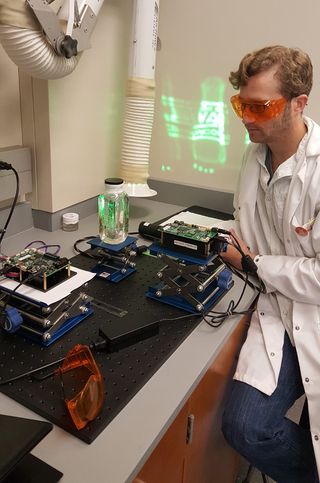Cool! 'Star Wars'-Like Tech Warps Light into 360-Degree 3D Images
"Help me, Obi-Wan Kenobi. You're my only hope." That famous message from Princess Leia to Obi-Wan, projected by R2-D2 as a holographic image in "Star Wars: Episode IV - A New Hope," sparked a childhood fascination for Alexander Lippert.
Now, as a chemist working at Southern Methodist University (SMU) in Dallas, Lippert is developing a new technique that may seem as though it were pulled straight from the classic movie.
"As a kid, I kept trying to think of a way to invent this," Lippert said in a statement from SMU. "Then, once I got a background in chemistry molecules that interact with light, and an understanding of photoswitches, it finally dawned on me that I could take two beams of light and use chemistry to manipulate the emission of light." [Worlds Collide: How NASA Is Making 'Star Wars' Real]
Lippert's new technology can create animated 3D table-top visualizations by structuring light. But this isn't a hologram being projected into thin air, like Leia's "Star Wars" scene. Rather, through an ingenious use of light and a special kind of chemistry, his team is developing a new imaging technique that creates a genuine 3D image inside a transparent cylinder, called a "volumetric display."
"Our idea was to use chemistry and special photoswitch molecules to make a 3D display that delivers a 360-degree view," Lippert said. "It's not a hologram; it's really three-dimensionally structured light."

The technology is based on a special molecule that can switch between fluorescent and nonfluorescent modes (known as photoswitching) when ultraviolet light is switched on and off. While the ultraviolet light shines on the molecule, it can produce its own light when hit by another beam of visible light — in this case, one produced by a projector bought from Best Buy. When the ultraviolet light is switched off, the molecule stops fluorescing. When many of these molecules in a transparent liquid solvent are activated and deactivated over time, a 3D animation can be set into motion inside the liquid.
"When you see a 3D movie, for example, it's tricking your brain to see 3D by presenting two different images to each eye," Lippert said. "Our display is not tricking your brain — we've used chemistry to structure light in three actual dimensions. So, no tricks — just a real three-dimensional light structure. We call it a '3D digital light photoactivatable dye display,' or '3D Light Pad' for short, and it's much more like what we see in real life."
Get the Space.com Newsletter
Breaking space news, the latest updates on rocket launches, skywatching events and more!
Laboratory testing of this technique can be seen in a video from the researchers.
A new study of the technique, published in the journal Nature Communications on July 11, describes how the 3D Light Pad could be used in future technologies. For example, in medical fields, a real-time 3D projection of an MRI scan could help radiologists recognize abnormalities such as cancer, Lippert said; an actual 3D image could deliver more information than a 2D computer monitor can.

The 3D image would look different to each of the observers at various locations around the display. Each person would have a different experience because he or she would be seeing different sides of the projected image or movie. This technique could be used for making "amusement parks, advertising, 3D movies and 3D games more lifelike, visually compelling and entertaining," according to the statement. [Travel to Mars (Virtually) with Apollo 11 Astronaut Buzz Aldrin]
Lippert's team manufactured this version of the 3D Light Pad for less than $5,000, and the cost to build would ultimately be less, Lippert said.
"For a really modest investment, we've done something that can compete with more expensive $100,000 systems," Lippert said. "We think we can optimize this and get it down to a couple thousand dollars or even lower."
The next step for Lippert's team is to move away from a liquid-solvent display to a solid-cube table display that would weigh the same as a television. They are also considering an aerosol display that would project onto a spray of droplets in the air — so Leia's hologram-like projection may not be so far, far away after all.
Follow Ian @astroengine and www.astroengine.com. Follow us @Spacedotcom, Facebook or Google+. Originally published on Space.com.
Join our Space Forums to keep talking space on the latest missions, night sky and more! And if you have a news tip, correction or comment, let us know at: community@space.com.
Ian O'Neill is a media relations specialist at NASA's Jet Propulsion Laboratory (JPL) in Southern California. Prior to joining JPL, he served as editor for the Astronomical Society of the Pacific‘s Mercury magazine and Mercury Online and contributed articles to a number of other publications, including Space.com, Space.com, Live Science, HISTORY.com, Scientific American. Ian holds a Ph.D in solar physics and a master's degree in planetary and space physics.
